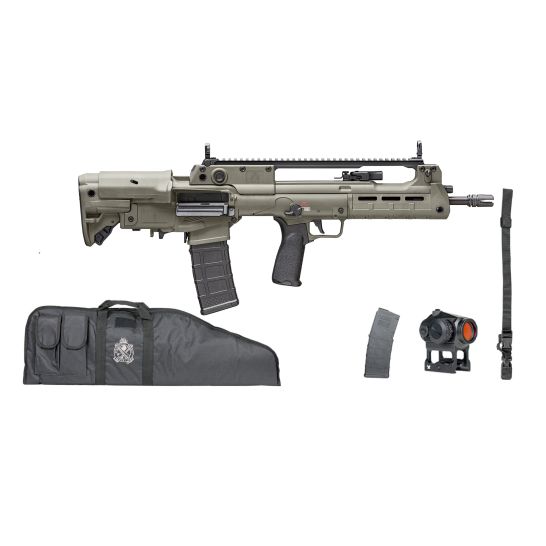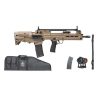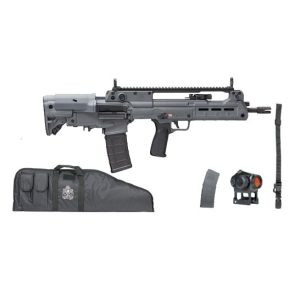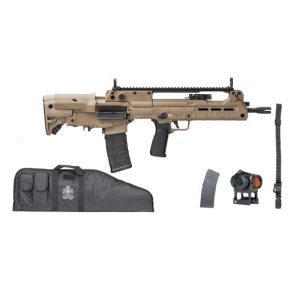Springfield Hellion Bullpup 5.56 16" 30rd Rifle Gear Up, OD Green – HL916556G-GU23 For Sale
$1,799.99
The Springfield Armory Hellion Bullpup 5.56 Rifle in OD Green offers impressive ballistic performance in a compact and versatile design, measuring only 28.25 inches long despite having a 16-inch barrel, thanks to its “bullpup” configuration that places the action behind the trigger. This design ensures excellent portability without compromising range or accuracy. The rifle caters to both left and right-handed users with its ambidextrous controls and reversible case ejection system. It features an adjustable short-stroke gas piston for reliable operation across various conditions, enhancing its functionality. Added features such as the Vortex Crossfire Optic for precise targeting, a single point sling for easy carrying, and a $200 voucher for Alexo Ready Wear, make the Hellion an ideal choice for those in search of a powerful and adaptable firearm.
Why are bullpups being phased out?
Bullpup rifles are being phased out in some military and law enforcement contexts due to several factors:
1. **Ergonomics and Handling**: Traditional layouts often provide better balance and more intuitive handling, especially in dynamic combat situations. The bullpup design can be unwieldy for some users, affecting rapid target acquisition and firing accuracy.
2. **Trigger Mechanics**: Bullpup rifles generally have longer and more complex trigger linkages, which can result in a less crisp trigger pull compared to conventional rifles, impacting precision shooting.
3. **Reload Speed**: Reloading can be slower and more cumbersome in bullpup rifles because magazines are positioned behind the grip, which can be less intuitive and more challenging under stress.
4. **Ejection Issues**: Bullpups often eject spent casings closer to the shooter’s face, which can be problematic for left-handed shooters unless the rifle has ambidextrous ejection capabilities.
5. **Maintenance and Complexity**: Bullpup designs can be more complex to disassemble and maintain, which may pose logistical challenges for field maintenance and repairs.
6. **Innovation and Trends**: Advances in modular rifle systems and other technological enhancements favor traditional layouts, providing more versatility, adaptability, and future-proofing.
Despite these reasons, bullpup rifles are still valued in certain scenarios for their compact design, which provides a longer barrel in a shorter package, offering advantages in confined spaces. The decision to phase them out depends on specific operational requirements and evolving tactical doctrines.
Is the Springfield Hellion worth it?
Determining whether the Springfield Hellion is worth it depends on several factors, including your specific needs, preferences, and budget. The Springfield Hellion is a semi-automatic rifle based on the Croatian VHS-2, featuring a bullpup design that makes it compact and well-balanced. Here are some pros and cons to consider:
### Pros:
1. **Compact Design:** The bullpup configuration allows for a shorter overall length without sacrificing barrel length, making it suitable for close-quarters scenarios.
2. **Quality Build:** Known for its solid construction and reliability.
3. **Ambidextrous Features:** It often includes ambidextrous controls, appealing to both left- and right-handed shooters.
4. **Customization:** Picatinny rails allow for mounting a variety of optics and accessories.
### Cons:
1. **Price:** It can be relatively expensive compared to other rifles in its category.
2. **Weight:** Some users find bullpup designs slightly heavier in the rear, though this can also aid in balance.
3. **Trigger Feel:** As with many bullpups, the trigger pull might not be as crisp as in traditional designs.
### Considerations:
– **Usage:** Consider what you mainly intend to use the rifle for, such as home defense, hunting, target shooting, or tactical training.
– **Budget:** Weigh the cost against other rifles that might meet your requirements, and compare features.
– **Ergonomics:** Personal handling and comfort are subjective; it’s helpful to hold and operate the rifle to see how it feels.
Ultimately, determining if the Springfield Hellion is worth it depends on weighing these pros and cons against your personal preferences and requirements.
What military uses the Hellion?
The Hellion is used by the British Army.
Why does the US military not use bullpup?
The U.S. military has historically not widely adopted bullpup firearms for several reasons:
1. **Training and Familiarity**: The U.S. military has long used traditional rifle configurations with the magazine located in front of the trigger. Adopting bullpup designs would require significant retraining for personnel accustomed to the standard layout.
2. **Ergonomics and Handling**: Bullpup designs have different handling characteristics, such as balance and feel. Some users find them less intuitive or comfortable compared to conventional rifles.
3. **Maintenance and Repair**: The U.S. military has extensive infrastructure and logistical systems geared toward maintaining and repairing traditional rifles. Introducing bullpup designs could complicate supply chains and require additional resources.
4. **Ejection Port Location**: Bullpup rifles often have the ejection port close to the shooter’s face, which can be problematic, especially for left-handed shooters, unless the design accommodates ambidextrous use.
5. **Proven Performance**: Traditional rifles like the M4 and M16 have proven effective and reliable in a wide range of conditions. The military often prefers to stick with battle-tested equipment.
6. **Modularity and Customization**: Conventional rifle designs typically offer greater flexibility for modular attachments like grenade launchers, optics, and other accessories.
While bullpup designs have certain advantages, such as a more compact form factor for the same barrel length, these benefits have not yet outweighed the advantages of sticking with the established, conventional rifle designs in use by the U.S. military.
Why did bullpups fall out of favor?
Bullpups fell out of favor for several reasons:
1. **Ergonomics and Handling**: Bullpup designs often have less ergonomic handling compared to traditional rifle configurations. The placement of the magazine and ejection port behind the trigger can lead to awkward reloads and difficulty in clearing malfunctions.
2. **Trigger Quality**: The design of bullpups can result in a less desirable trigger pull. Because the trigger mechanism needs to extend to the rear where the firing mechanism is located, it can result in a mushy or less responsive trigger feel.
3. **Balance and Weight Distribution**: While bullpups are designed to be compact, their weight distribution can be less favorable, affecting shooting stability and comfort, especially for prolonged use.
4. **Left-Handed Use**: Some bullpup models are challenging for left-handed shooters due to the location of the ejection port, which can result in spent casings hitting the shooter’s face.
5. **Operational Complexity**: The internal mechanisms of bullpup rifles can be more complex and harder to service, leading to potential reliability issues and difficulties in maintenance.
6. **Preference for Modular Rifles**: Many military and law enforcement agencies prefer modular rifle platforms like the AR-15/M16 family, which offer extensive customization options that are typically more limited in bullpup designs.
These factors, combined with user preference and familiarity with traditional rifle designs, have contributed to the decreased popularity of bullpup configurations.
Why is Israel replacing the Tavor?
Israel is replacing the Tavor assault rifle with the more traditional M4 carbine and M16 rifles for several reasons. One of the primary factors is the preference for a lighter and more compact weapon in various combat scenarios. The M4 and M16 are generally lighter than the Tavor, making them more suitable for prolonged use by soldiers. Additionally, the transition is part of a broader shift towards standardizing weapons systems across the military to improve logistical support and training efficiency. The familiarity and widespread use of the M4 and M16 by allied forces also contribute to this decision, facilitating interoperability and simplifying maintenance and supply chains.
Does the Hellion use AR mags?
No, the Hellion does not use AR magazines. The Springfield Armory Hellion uses proprietary Croatian-made magazines.
Can you shoot .223 in a Springfield Hellion?
Yes, you can shoot .223 Remington ammunition in a Springfield Hellion. The Springfield Hellion is chambered for 5.56 NATO, which is compatible with both 5.56 NATO and .223 Remington cartridges.
Are ghost guns reliable?
Ghost guns, which are homemade or 3D-printed firearms lacking serial numbers and often assembled from kits, have varying levels of reliability. Their reliability depends on the quality of the parts used and the skill of the person assembling them. Some ghost guns can be as reliable as commercially manufactured firearms if high-quality components are used and assembled correctly. However, due to the diverse sources of parts and varying levels of craftsmanship, the reliability of ghost guns can be inconsistent.
Where is the Springfield Hellion made?
The Springfield Hellion is made in Croatia.
What does the name Hellion mean?
The name “Hellion” generally refers to a rowdy, disruptive, or troublemaking person, often used to describe a mischievous child. It carries connotations of being wild and unruly. In some contexts, it can also evoke a sense of rebelliousness or a tendency to cause chaos.
What gun has a magazine behind the trigger?
The gun that has a magazine located behind the trigger is known as a “bullpup” design. In bullpup firearms, the action and magazine are positioned behind the trigger group. This configuration allows for a more compact weapon while maintaining a standard barrel length. Some well-known examples of bullpup firearms include the Steyr AUG, the FAMAS, and the IWI Tavor.
Why don’t Americans like bullpups?
Bullpup rifles, which have the action and magazine located behind the trigger, often face criticism in the United States for several reasons:
1. **Ergonomics and Balance:** Many American shooters find bullpup designs awkward due to their unconventional balance and feel. The concentration of weight towards the rear can make handling and aiming feel unfamiliar, especially to those accustomed to traditional rifle designs.
2. **Trigger Feel:** Bullpup designs can suffer from poorer trigger feel and responsiveness because of the longer linkage systems required to connect the trigger to the action located at the rear, leading to a spongy or less responsive trigger pull.
3. **Magazine Changes:** The location of the magazine behind the trigger can make reloading slower and more cumbersome compared to traditional rifles. This can be off-putting for users who prioritize quick magazine changes.
4. **Customization and Accessories:** Traditional rifles often have more available options for customization in terms of stocks, grips, and other accessories. Bullpup designs might offer fewer options, which can be a downside for users who enjoy personalizing their firearms.
5. **Cultural Preference:** In the U.S., there is a strong cultural preference for the AR-15 platform and other traditional rifle designs. Familiarity, historical preference, and widespread availability of parts and accessories make traditional rifles more appealing to many American shooters.
6. **Legal and Perception Issues:** In some areas, bullpup rifles can be legally complicated due to minimum length regulations, since bullpups can be quite compact. Additionally, their futuristic appearance might lead to misconceptions and negative perceptions among those unfamiliar with the design.
These factors, combined with a general preference for traditional rifle designs, contribute to why bullpups might be less favored among American shooters.
Are bullpups illegal?
The legality of bullpup firearms varies by country and sometimes even by regions within a country. In general:
– **United States**: Bullpup rifles and shotguns are legal in most states, but some states have restrictions or bans on certain configurations of firearms, including bullpups. States like California and New York have stringent gun laws that may affect the legality of certain bullpup models.
– **United Kingdom**: Bullpup rifles are generally legal, but all firearms ownership is heavily regulated.
– **Australia**: Firearm laws are strict, and the legality of bullpup designs depends on the class of license and local state regulations.
– **Canada**: Generally, bullpup firearms are legal, but specific models may be classified as restricted or prohibited.
Always check the specific laws in your jurisdiction for the most accurate and up-to-date information.
Are bullpups slower to reload?
Bullpup rifles typically have their magazine and action located behind the trigger, closer to the shooter’s shoulder. This design can make reloading slower and more cumbersome compared to traditional rifle configurations. The most common issue is that the shooter must reach further back to access and replace the magazine, which can disrupt the shooting stance and sight alignment. This might be less intuitive and require more practice to execute quickly. However, with adequate training and familiarity, shooters can become proficient and effectively mitigate slower reload times.
| Model | Hellion |
|---|---|
| Action | Semi-Auto |
| Overall Length | 28.25"-29.75" |
Be the first to review “Springfield Hellion Bullpup 5.56 16" 30rd Rifle Gear Up, OD Green – HL916556G-GU23” Cancel reply
Related products
Springfield Hellion Bullpup
Springfield Hellion Bullpup 5.56 16" 30rd Rifle Gear Up, Gray – HL916556Y-GU23
Springfield Hellion Bullpup
Springfield Hellion Bullpup 5.56 16" 30rd Rifle Gear Up, Flat Dark Earth -HL916556F-GU23




Reviews
There are no reviews yet.